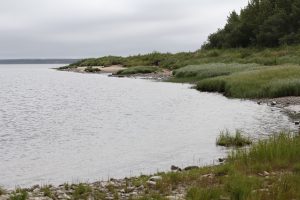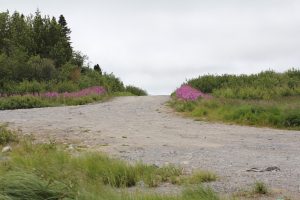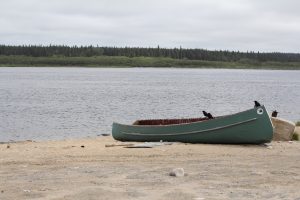 By Tim Parr
By Tim Parr
July 28th, 2021. After working from home for the duration of the pandemic, I received last minute confirmation that I would be travelling up to the Cree community of Chisasibi by plane (specifically on a Dash 8-3000) in order to produce a Gladue report.
Prior to this, I conducted research into various topics, such as access to inmates during the pandemic for the purposes of producing reports as well as interviewing families in and out of isolation. To become a certified Gladue writer, I first had to undergo training and produce a mock report. This was the first stage in my work as an intern for the Department of Corrections and Services (Cree Nation Government).
First year law students are, presumptively, well acquainted with Gladue. In 1995, Jaimie Gladue, a young, 19-year-old Cree woman, fatally stabbed her boyfriend at a birthday celebration. Both Ms Gladue and her boyfriend were heavily intoxicated at the time of the tragedy and had a history of domestic abuse.
Initially, Ms Gladue was charged with second degree murder, but plead guilty to manslaughter (see Gladue Primer at 4). The sentencing judge took into consideration the aggravating factors and sentenced Ms Gladue to three years. However, the sentencing judge failed to take into consideration the accused’s Indigenous status.
This oversight provided the grounds for Ms Gladue’s appeal to the British Colombia (BC) Court of Appeal. The BC Court of Appeal dismissed the appeal, upholding the trial judge’s initial sentence. Ms Gladue and her lawyer appealed this decision to the Supreme Court of Canada (SCC) in 1999 on the grounds that s 718.2(e) of the Canadian Criminal Code was not considered by the sentencing judge which, therefore, amounted to an error in law.
The SCC ruled it an error not to grant Ms Gladue special consideration. In effect, the Gladue decision, and its ensuing framework, ensure that Indigenous offenders can exercise their rights under s 718.2(e), which stipulates that “all available sanctions, other than imprisonment, that are reasonable in the circumstances and consistent with the harm done to victims or to the community should be considered for all offenders, with particular attention to the circumstances of Aboriginal offenders.” The purpose of this provision is to find alternatives to punitive forms of sentencing for Indigenous people, such as restorative and culturally appropriate practices. In part, this may consist of drug and alcohol treatment, anger management or counselling (Ibid at 3). S 718.2(e) is remedial in nature. It attempts to mitigate the overrepresentation of Indigenous peoples in federal and provincial prisons across Canada. Moreover, judges take notice of the systemic factors afflicting Indigenous people.
Yet despite the precedent set by Gladue and, the concept of stare decisis, Canadian Courts have either inconsistently applied the framework set by Gladue or ignored it altogether. In 2012, it was necessary for the SCC to reaffirm Gladue with Ipeelee. The Ipeelee Court acknowledged that “systemic and background factors may bear on the culpability of the offender, to the extent that they shed light on his or her level of moral blameworthiness” (at para 73). Current concepts of sentencing are inappropriate because they have frequently not responded to the needs, experiences and perspectives of Indigenous people or Indigenous communities (Ipeelee at para 74). Indigenous offenders find themselves in situations of social and economic deprivation with a lack of opportunities and limited options for positive development (Ibid at para 73). The reasons for this are tied to Canada’s colonial history and its assimilatory practices. As a background/systemic factor, a Gladue report considers the history of the community where the individual lives.

For instance, Chisasibi is one of the most populous of the communities located in Eeyou Istchee/Cree Territory in northern Quebec (see Morneau at 2). Chisasibi is on the eastern shore of James Bay. Like the other communities (e.g., Waswanipi, Oujé-Bougoumou or Mistissini), hydroelectric development and the signing of the James Bay Agreement resulted in the sedentarization of the Chisasibi Cree. The Chisasibi Cree initially inhabited the village of Fort George and were nomadic. Fort George closed in 1980. Fearing the threat of floods caused by hydroelectric development (which there were—an estimated 10 000 caribou perished, and fish were contaminated by mercury), the Cree settled in the community of Chisasibi, also known as the great river.

However, sedentarization created a gulf between generations. The young never knew the nomadic lifestyle of their elders (Ibid at 4). Sedentarization was an attempt to assimilate the Cree. Functions previously performed by families became the responsibility of non-Indigenous institutions, such as schools and churches (Ibid). Mothers lost their role as teachers and fathers no longer performed their traditional roles as providers for their family and as managers of the land’s resources (Ibid). This situation is not germane to the Cree. Kim Anderson explains that Mohawk women traditionally held authority in the political, social, economic and spiritual areas of society (at 85-86). Western norms centered on patriarchy and supremacy of the state, displaced the position of matriarchal power for the sake of a worldview consonant with its own.

Sedentarization led to intergenerational consequences for the Cree. Children were taken away from their parents and forced to attend residential schools where they were subjected to abuse, trauma and acculturation. “Social, political, economic, demographic and territorial upheavals have marked the history of the community of Chisasibi since the first contacts with Europeans” (Morneau at 6). A Gladue report takes these factors into consideration and further traces the history of the individual’s family. It is the Gladue writer’s task to tell the individual’s story, not in the writer’s words, but in the words of the individual, as much as possible.
The writer interviews the individual and objectively presents their story to the sentencing judge, so that the judge can better understand how it is that the individual arrived at their current station. That is, what in the individual’s life pushed them to commit the offense.

The Gladue process presents many challenges. Not only must the writer avoid any bias (either in favour or against the individual), but they must also recognize that the interview may cause the individual to remember traumatic events that they have pushed from their mind. Shortcomings to Gladue are tied to this latter point. Support for individuals following the interview with the writer appear to be lacking. Without proper support mechanisms, there is the risk of regression. Fortunately, community actors are working to fill this void.
Elsewhere, Professor Marie Manikis has argued that the Gladue principles should be elevated to a principle of fundamental justice (at 1). All state agencies with capacity to affect the freedom interests of Indigenous people ought to be bound by the Gladue framework. This would meaningfully address its inconsistent application and bring greater attention to the overrepresentation of Indigenous peoples in federal and provincial prisons across the country.

Come next week, I will be leaving Chisasibi to head south to Val D’Or. From Val D’Or I will travel to Mistissini to continue my work as a writer for the Department of Corrections and Services (Cree Nation Government). More to come.
Miigwech,
Tim
JURISPRUDENCE
R v Gladue, Supreme Court of Canada, 1 SCR 688 (1999).
R v Ipeelee, Supreme Court of Canada, 1 SCR 433 (2012).
SECONDARY MATERIALS
Community History of Chisasibi produced by Jerome Morneau for use in Gladue Reports, Ministry of Justice, Québec, 2015.
Manikis, Marie. Towards Accountability and Fairness for Aboriginal People: The Recognition of Gladue as a Principle of Fundamental Justice That Applies to Prosecutors (2016).
Tungasuvvingat Inuit (TI), Gladue Primer.
